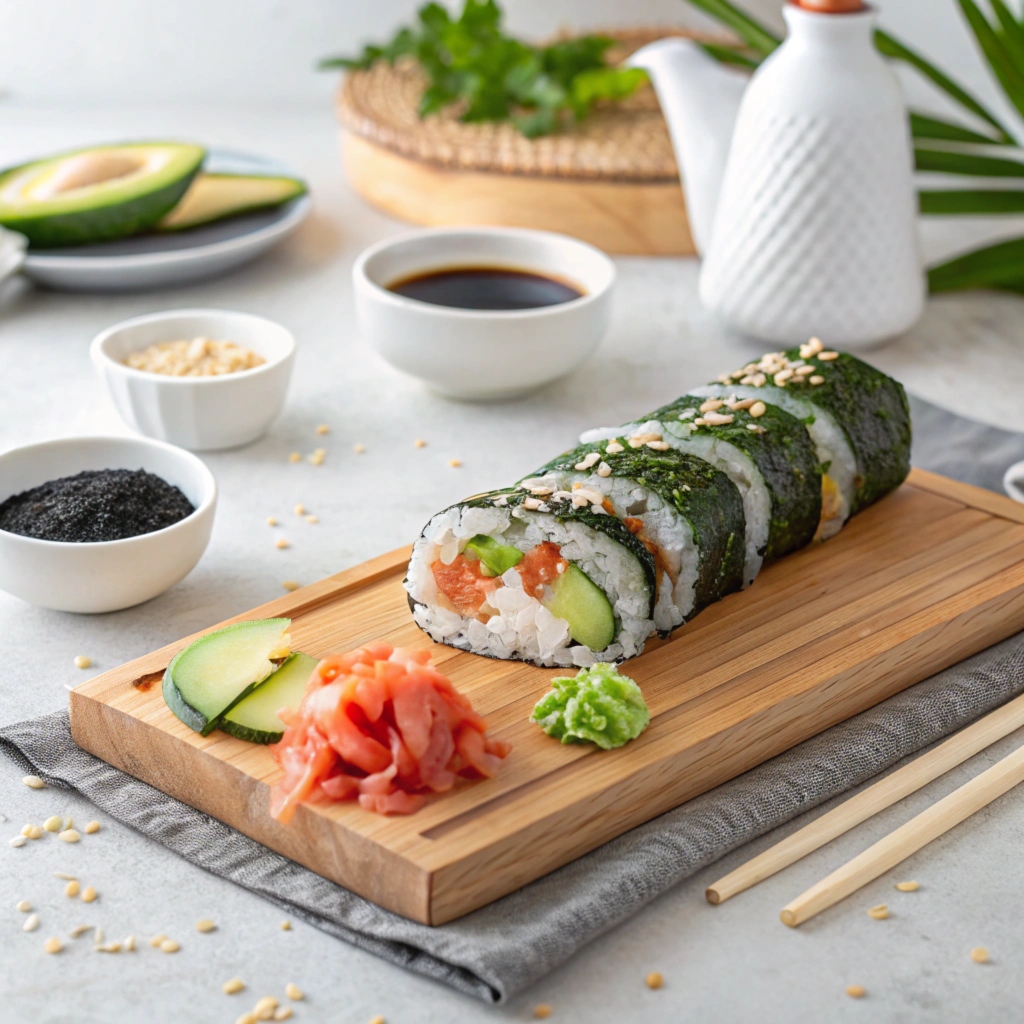What is an Alaska Roll?
If you’re a sushi lover, chances are you’ve asked yourself, Is the Alaska Roll Healthy? This fusion-style sushi roll typically features a combination of salmon, avocado, cucumber, and sometimes crab, all wrapped in rice and seaweed. Often served raw or slightly torched, the Alaska Roll is celebrated for its melt-in-your-mouth texture and balance of fresh, nutrient-rich ingredients.
“The Alaska roll isn’t just food—it’s an experience, combining freshness, creaminess, and umami in every bite.”
Ingredients Commonly Found in an Alaska Roll
Let’s break it down ingredient by ingredient:
- Salmon: Packed with omega-3 fatty acids and protein, this is the star of the show.
- Avocado: A creamy addition that’s rich in heart-healthy fats.
- Cucumber: Adds crunch and hydration with minimal calories.
- Rice: Provides the carbs for energy, but it’s typically white rice, which some might consider less nutritious.
- Seaweed (Nori): A nutritional powerhouse that’s full of iodine and trace minerals.
Whether you’re looking for a quick lunch or a dinner that satisfies, this roll brings balance to the plate—at least at first glance.
Nutritional Breakdown of the Alaska Roll
Caloric Content of an Alaska Roll
How many calories are in your favorite roll? The typical Alaska roll contains about 300–400 calories per serving, depending on portion size and preparation. It’s a relatively low-calorie meal, but watch out for additional sauces or toppings that can add extra calories.
| Component | Calories | Protein (g) | Carbs (g) | Fat (g) |
|---|---|---|---|---|
| Salmon (3 oz) | 120 | 17 | 0 | 5 |
| Avocado (½ medium) | 120 | 1 | 6 | 11 |
| Rice (½ cup cooked) | 120 | 2 | 26 | 0 |
| Seaweed (1 sheet) | 10 | 1 | 1 | 0 |
Macronutrient Analysis: Protein, Carbs, and Fats
- Protein: The Alaska roll offers 10–15g of protein per serving, mostly from the salmon.
- Carbs: With sushi rice being the primary carbohydrate source, it provides about 30–40g of carbs.
- Fats: The avocado and salmon contribute 10–15g of healthy fats, essential for brain and heart health.
Vitamins and Minerals Found in an Alaska Roll
Did you know that every Alaska roll is like a mini vitamin pill? Here’s why:
- Vitamin D: From salmon, which supports strong bones and immune health.
- Vitamin E: Thanks to the avocado, a key player in skin and hair health.
- Iodine: From the seaweed, crucial for thyroid function.
Health Benefits of the Alaska Roll
High in Omega-3 Fatty Acids
One of the standout benefits of the Alaska roll is its high content of omega-3 fatty acids, thanks to the salmon. These essential fats are known for their ability to reduce inflammation, support heart health, and boost brain function. Omega-3s are like the “oil” for your body’s engine, keeping everything running smoothly. If you’re looking to protect your heart and sharpen your mind, an Alaska roll can be a delicious addition to your diet.
A Source of Lean Protein
Protein is the building block of our muscles, skin, and even hormones. The Alaska roll is packed with lean protein from salmon and sometimes crab. Each roll contains approximately 10–15 grams of protein, making it a satisfying meal that keeps you full longer. Protein also helps with muscle recovery after a workout, so if you’re hitting the gym, this roll can be a tasty post-exercise meal.
Low-Calorie Options for Weight Management
Trying to shed some pounds but still enjoy your favorite foods? The Alaska roll offers a relatively low-calorie option compared to other calorie-dense meals. With about 300–400 calories per serving, it’s light yet filling. However, skipping heavy sauces like mayo or cream cheese can keep your sushi leaner and healthier. It’s proof that good food doesn’t have to mean loads of calories!
Potential Health Concerns and Drawbacks
Sodium Levels in Sushi Rolls
Here’s the catch: sushi rolls, including the Alaska roll, can sometimes be high in sodium. Soy sauce and certain seasonings can push your daily sodium intake over the edge, potentially leading to water retention or even high blood pressure. The good news? You can opt for low-sodium soy sauce or skip it altogether. Trust me, the roll tastes just as good without it!
Mercury Content in Fish: Is It a Risk?
Fish like salmon are healthy, but they can sometimes carry trace amounts of mercury. While the levels in salmon are generally low compared to larger fish like tuna, it’s still worth keeping in mind if you’re pregnant or eating a lot of sushi. Moderation is key—enjoy your Alaska roll but don’t make it your every-single-day meal.
Allergy Concerns: Fish, Shellfish, and Other Ingredients
Let’s not forget about allergies. The Alaska roll contains fish and sometimes crab, both of which are common allergens. Additionally, seaweed and even rice vinegar might cause reactions in sensitive individuals. If you’re new to sushi or serving it to someone else, it’s always a good idea to check for allergies first.
“When in doubt, consult the chef or stick to ingredients you know are safe for you.”
Is the Alaska Roll Suitable for Specific Diets?
Low-Carb and Keto Diets
Following a low-carb or keto diet? The Alaska roll might not be the best fit because of the rice, which is high in carbohydrates. However, you can ask for a “naked” roll (without rice) or swap the rice for a cucumber wrap to keep it keto-friendly. Sushi innovation at its finest!
Gluten-Free Options and Modifications
Believe it or not, sushi isn’t always gluten-free. Soy sauce, imitation crab, and some marinades may contain gluten. If you’re gluten-sensitive, look for certified gluten-free soy sauce and ensure your roll is made with real crab and unseasoned fish.
Vegetarian or Vegan Variations
Craving an Alaska roll but don’t eat fish? No problem! You can replace the salmon with a marinated tomato or carrot “salmon” substitute and use vegan cream cheese for a plant-based twist. The flavors and textures might surprise you—they’re just as satisfying as the original.
Common Problems and Solutions with Sushi Rolls
Problem: Finding High-Quality Sushi Ingredients
Making Alaska Rolls at home can be a fun and rewarding experience, but finding high-quality ingredients can sometimes feel like hunting for a needle in a haystack. Fresh fish is crucial, especially sushi-grade salmon for Alaska Rolls, but not all grocery stores carry it. Additionally, essential items like nori and authentic rice vinegar might not always be readily available.
Solution: Sourcing Fresh and Reliable Products
To tackle this, look for specialty stores or Asian markets in your area that stock fresh ingredients specifically for making Alaska Rolls. If that’s not an option, many online retailers now offer convenient sushi kits and sushi-grade fish delivered straight to your door. When buying fish, always ensure it’s labeled “sushi-grade” or “safe for raw consumption.” This simple step not only elevates the taste of your Alaska Rolls but also guarantees they’re safe to enjoy!
Problem: Hidden Calories in Sauces and Add-Ons
You’ve ordered an Alaska roll, thinking it’s a healthy option, but then it arrives drenched in spicy mayo or creamy sauces. These extra toppings can significantly increase the calorie count, turning your light meal into a calorie bomb.
Solution: Choosing Healthier Alternatives
Skip the mayo-based sauces and consider asking for your Alaska Roll “plain” to keep it lighter. For added flavor without extra calories, try dipping your roll in low-sodium soy sauce or a splash of tangy ponzu. If you’re making Alaska Rolls at home, a great alternative to spicy mayo is Greek yogurt mixed with a touch of sriracha—it’s healthier while still packing a flavorful punch!
Is Alaska the Healthier Roll at Home
Making your own Alaska roll not only allows you to control the ingredients but also ensures freshness. Plus, it’s a fun activity that lets you unleash your inner chef!
Ingredient Substitutions for Healthier Choices
Want to make a guilt-free Alaska roll? Here are some swaps to consider:
- Replace white rice with cauliflower rice for a low-carb option.
- Use brown rice instead of white rice for added fiber.
- Opt for low-sodium soy sauce or coconut aminos.
- Substitute cream cheese or mayo with avocado slices or Greek yogurt-based sauces.
Step-by-Step Guide to Homemade Alaska Rolls
Here’s a simple way to make your Alaska roll at home:
- Prepare the Ingredients:
- Slice sushi-grade salmon thinly.
- Cut cucumber and avocado into strips.
- Cook and season sushi rice with rice vinegar.
- Set Up Your Workstation:
Lay a bamboo sushi mat on a clean surface and cover it with plastic wrap for easy rolling. - Assemble the Roll:
- Place a sheet of nori shiny-side down on the mat.
- Spread a thin, even layer of rice on the nori.
- Arrange the salmon, avocado, and cucumber in a line near one edge.
- Roll It Up:
Use the bamboo mat to tightly roll the sushi into a cylinder. Apply gentle pressure to keep everything in place. - Slice and Serve:
- Wet a sharp knife with water and cut the roll into even slices.
- Serve with soy sauce, pickled ginger, and wasabi on the side.
“Making sushi is all about practice. Don’t worry if your first roll isn’t perfect—it’ll still taste amazing!”
Conclusion: Is the Alaska Roll a Healthy Choice?
Weighing the Pros and Cons
The Alaska roll is a delicious and nutritious option, but like all foods, it’s best enjoyed in moderation. With its omega-3-rich salmon, heart-healthy avocado, and satisfying texture, it ticks many boxes for a balanced meal. However, sodium and potential mercury levels are considerations to keep in mind.
Making Informed Choices for a Balanced Diet
At the end of the day, whether or not the Alaska roll is healthy depends on how you enjoy it. Skip the extra sauces, be mindful of portions, and pair it with fresh sides like a seaweed salad or miso soup. With these tips, you can enjoy your favorite sushi guilt-free!

